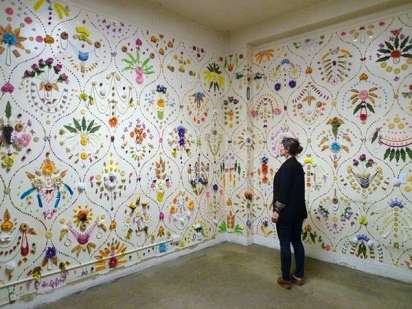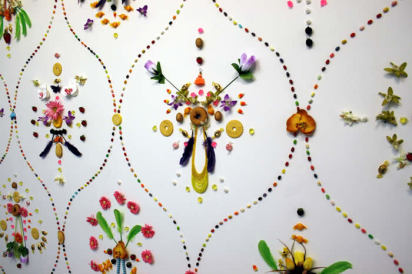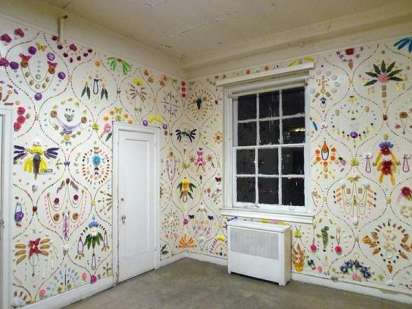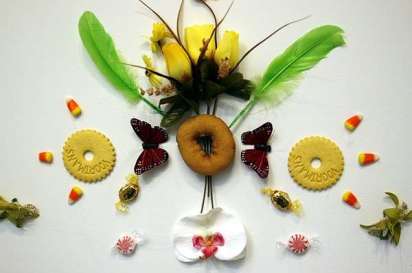
There’s something to be said for the absurdity of a facade: the forced smiles we don during frustrating encounters, the airbrushed images and whitened teeth and perfectly manicured lawns. But we all do it, for a variety of reasons. It’s kind. It’s tradition. It’s expected. Yet, sometimes, it’s imperative that we peel back the curtain a bit – just to take a peek at what lies deeper. Just like Adam Parker Smith peeling back the curtain (err, wallpaper) at the Andrew Freedman Home in the Bronx.

You’ve heard of the Andrew Freedman Home, yes? It was a bizarre attraction that opened in the 1930’s – a retirement home for formerly wealthy individuals who had lost their riches during the Great Depression. Affectionately described as “being poor in style,” the home boasted white glove service, ballrooms, libraries and billiards – even private opera performances. It’s funny; even though each guest had no money to their names, they sought to afford the perks of the lifestyle they’d grown accustomed to living. What good were food and shelter if not dining with polished silver or sleeping on satin sheets?

The Andrew Freedman Home had a short-lived life and was abandoned in the 70’s where large portions of the house laid vacant. Until 2012, when NYC-based public art exhibition curators No Longer Empty sent in a team of talented artists to transform the lot into a commissioned installation. And for Brooklyn-based artist Adam Parker Smith, he used the opportunity to explore our feelings about wealth and masks and The Jones’ with which we keep.

His installation offered an alternative wallpaper for the space – an enlarged pattern emulating a traditional motif, but upon closer inspection, revealed an array of plastic flowers and fruit, varnished baked goods, cheap hard candies, jelly beans and costume jewelry. “While the materials alluded to opulence, they were purchased inexpensively at a dollar store,” Adam writes. “There was a cheery hopefulness to the arrangement that suggested both optimism in the midst of loss, and the absurdity of keeping up a good facade.”

And I imagine that’s what the guests of the Andrew Freedman Home felt each evening as they hung their hats on the extravagant beds they could no longer afford. I imagine, sometimes, that’s what we feel like as we choose consumption over conservation and more over less. And I wonder: when is our time? Is society our own personal Andrew Freedman Home, catering to our fancy desires for buttery leather bags and fine cashmere? Serving us affirmations of “It’s OK, you deserve these shoes.” and “Reward your hard work!” on a silver platter? Are we living within the four walls of our own facade, enjoying the finer things we can’t (shouldn’t?) afford?

I don’t know. I do know, however, that I have two closets filled to the brim and a pit in my stomach for every impulse purchase and inexpensive reward I’ve indulged in over the years. And perhaps it’s time, for me at least, to check out of my own Andrew Freedman Home and head home.
Image Credits: No Longer Empty and Most Metro


This is such a lovely article. I can’t imagine how long it would take to create that instillation; it’s absolutely wonderful. Also, thank you for sharing your views on consumerism, it is definitely some food for thought. It’s amazing how easily we get caught up, not only with keeping up with the Jones’, but trying to keep up with where we think that we should be ourselves (whether or not we are actually there).
By the way, I know it has been this way for a little bit now, but I really like your new take on your blog. :)
Thank you, Laura, for your kind words on the site, and for your refreshing thoughts! I think you raised a great point – we often place these crazy expectations on ourselves, as well, whether we realize it or not. Food for thought indeed!
Love this post–for both the images and the ideas. My own thinking about wealth and consumerism and all of this started about 3 years ago, when I participated in Project 333, a minimalist clothing experiment. I had stuffed closets, too, and nothing to wear. Living with 33 items only for 3 months completely changed my relationship with clothing, which was the beginning of changing my relationship with all things. Ironically, I now have fewer things but actually have more material luxury in my life.
Ohhhh, I would love to read about your Project 333 experience – did you write about it online? I’d love a link!
Hi Erin–
I wrote this piece for the Project 333 blog a while back: http://theproject333.com/how-clothing-shapes-our-lives/
And this one on my old blog; http://intertidalyears.wordpress.com/2011/02/02/project-333-lotta-lessons-for-day-1/
OMG Rita, such beautiful stories here! I was the SAME way in jr. high – not a lot to choose from – and it’s made me somewhat of a clothes hoarder. But, like you, I’m realizing that quantity certainly doesn’t mean I have many options, and when my closet is cleaner/more edited, I can see more and work with what I’ve got. Also, amen to getting dressed no longer being a chore. I feel this way now that I’ve settled on a daily “mom” uniform – gray v-neck, boyfriend jeans and moccasins! Done. :)
What a thought provoking post. Raising children in this consumer driven world presents some interesting challenges. Even at a young age they are being impacted by the message that such and such a product will make you happier, or that they need a certain item to be legitimate in their peers’ eyes. These trends are hard for adults to buck, let alone little hearts and minds that are just awakening to the human condition.
SUCH a good thought, Jody. Ah, I worry about these kids – so many more challenges they’re faced with than we were in our generation!
It’s unfortunate that you cannot keep up criticism or the truth–your blog is clearly not an open forum for critique and considering it is sub par. you might as well keep some integrity by removing negative comments.
nice job both of you.
Hi E:
I deleted your comment because your allegation seemed inflammatory and unsubstantiated, yet after doing a bit of research into Flat Vernacular’s sticker wallpaper, I do see an influence. However, I am not equipped to point fingers and place blame re: copycat artists, as I believe this stifles the very act and purpose of creativity. Everything is influenced by the connections we make, either subconsciously or consciously. I choose to believe that we’re all products of an inspired combination of art, history, science, design, etc. – and that, truly, there is nothing new under the sun.
I do hope that it was not Adam’s intent to imitate Flat Vernacular’s sticker wallpaper, but it is not up to me to judge this. It is, however, up to me to manage and moderate the comment section so that it doesn’t become a breeding ground for hate, blame and slander. I did not read your comment as a constructive critique. Instead, I read it as an aggressive and negative statement (anonymously, at that) toward an artist I’ve featured, and there is a big difference. I welcome the former and do not condone the latter.
I do hope you understand.
e.
Well, the walls are gorgeous what dedication to make it.